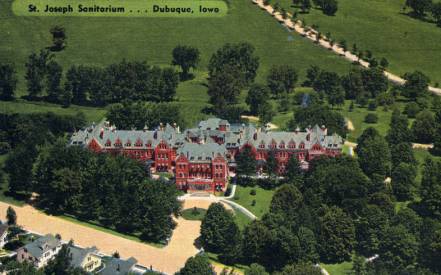Encyclopedia Dubuque
"Encyclopedia Dubuque is the online authority for all things Dubuque, written by the people who know the city best.”
Marshall Cohen—researcher and producer, CNN
Affiliated with the Local History Network of the State Historical Society of Iowa, and the Iowa Museum Association.
ST. JOSEPH'S SANITARIUM: Difference between revisions
(Created page with "left|thumb|350px|Saint Joseph's SanitariumST. JOSEPH'S SANITARIUM. Medical facility established by the SISTERS OF MERCY. Located on Asbury Road, t...") |
No edit summary |
||
| Line 1: | Line 1: | ||
[[Image:SANITARIUM.jpg|left|thumb|350px|Saint Joseph's Sanitarium]]ST. JOSEPH'S SANITARIUM. | [[Image:SANITARIUM.jpg|left|thumb|350px|Saint Joseph's Sanitarium]]ST. JOSEPH'S SANITARIUM. A medical facility established by the [[SISTERS OF MERCY]], the sanitarium was located on Asbury Road and was originally known as the Insane Asylum of West Dubuque. This name was changed to St. Joseph's Sanitarium in November 1909. | ||
The institution, dedicated on June 7, 1896, with Archbishop [[HENNESSY, John|John HENNESSY]] in attendance, was described as five different buildings semi-connected in the form of a Roman cross. A four-story administration building standing at the front was flanked by two four-story wings, one reserved for male patients and the other for females. Constructed between the wings and linked to the administration building was a chapel. | The institution, dedicated on June 7, 1896, with Archbishop [[HENNESSY, John|John HENNESSY]] in attendance, was described as five different buildings semi-connected in the form of a Roman cross. A four-story administration building standing at the front was flanked by two four-story wings, one reserved for male patients and the other for females. Constructed between the wings and linked to the administration building was a chapel. | ||
| Line 5: | Line 5: | ||
The sanitarium was designed by architects Buechner and Jaconson of St. Paul, Minnesota, to accommodate five hundred patients. Twenty-two acres of grounds were associated with the buildings. Despite the initial plans, the sanitarium was expanded in 1897 and became known as [[ST. ANTHONY'S HOME FOR THE AGED]]. | The sanitarium was designed by architects Buechner and Jaconson of St. Paul, Minnesota, to accommodate five hundred patients. Twenty-two acres of grounds were associated with the buildings. Despite the initial plans, the sanitarium was expanded in 1897 and became known as [[ST. ANTHONY'S HOME FOR THE AGED]]. | ||
Condemned by state health and fire authorities, the facility | Condemned by state health and fire authorities, the facility was closed and stood vacant beginning on April 29, 1967, when the last thirty-two patients were transferred to the Mental Health Department at Mercy Hospital. The function of the facility, along with that of St. Anthony’s Home, became part of the [[MERCY MEDICAL CENTER]]. The sanitarium officially closed on June 30, 1967. | ||
In 1968 the land and buildings were sold to the [[UNIVERSITY OF DUBUQUE]]. Demolition of the buildings began during July to make room for a planned seminary complex. | In 1968 the land and buildings were sold to the [[UNIVERSITY OF DUBUQUE]]. Demolition of the buildings began during July to make room for a planned seminary complex. When these plans were abandoned the land was converted to [[UNIVERSITY PARK]]. This property was later the site of the Red Cross building in Dubuque. | ||
[[Category: Health Care]] | [[Category: Health Care]] | ||
[[Category: Postcards]] | [[Category: Postcards]] | ||
[[Category: Baths]] | [[Category: Baths]] | ||
Revision as of 17:00, 18 December 2015
ST. JOSEPH'S SANITARIUM. A medical facility established by the SISTERS OF MERCY, the sanitarium was located on Asbury Road and was originally known as the Insane Asylum of West Dubuque. This name was changed to St. Joseph's Sanitarium in November 1909.
The institution, dedicated on June 7, 1896, with Archbishop John HENNESSY in attendance, was described as five different buildings semi-connected in the form of a Roman cross. A four-story administration building standing at the front was flanked by two four-story wings, one reserved for male patients and the other for females. Constructed between the wings and linked to the administration building was a chapel.
The sanitarium was designed by architects Buechner and Jaconson of St. Paul, Minnesota, to accommodate five hundred patients. Twenty-two acres of grounds were associated with the buildings. Despite the initial plans, the sanitarium was expanded in 1897 and became known as ST. ANTHONY'S HOME FOR THE AGED.
Condemned by state health and fire authorities, the facility was closed and stood vacant beginning on April 29, 1967, when the last thirty-two patients were transferred to the Mental Health Department at Mercy Hospital. The function of the facility, along with that of St. Anthony’s Home, became part of the MERCY MEDICAL CENTER. The sanitarium officially closed on June 30, 1967.
In 1968 the land and buildings were sold to the UNIVERSITY OF DUBUQUE. Demolition of the buildings began during July to make room for a planned seminary complex. When these plans were abandoned the land was converted to UNIVERSITY PARK. This property was later the site of the Red Cross building in Dubuque.


